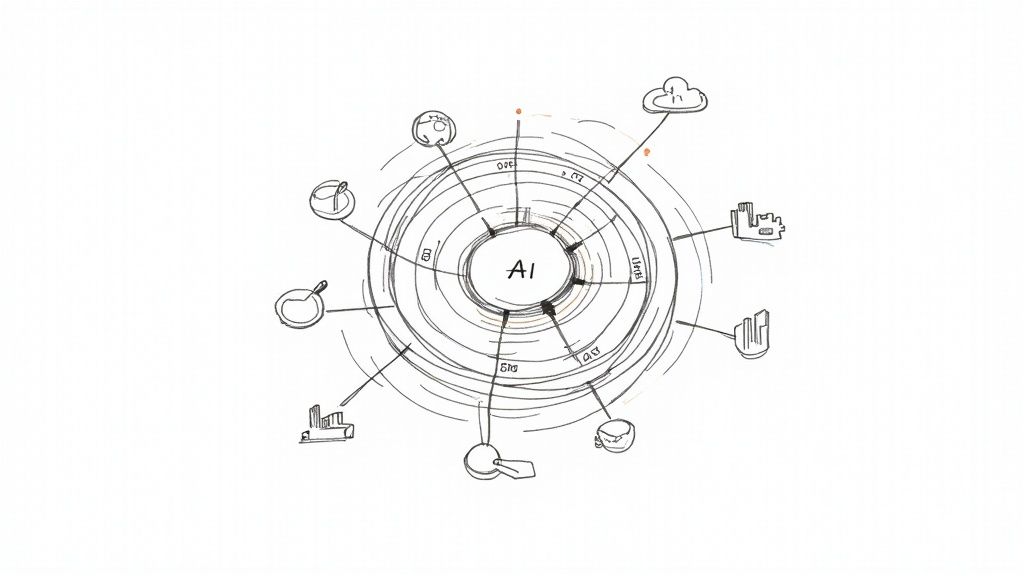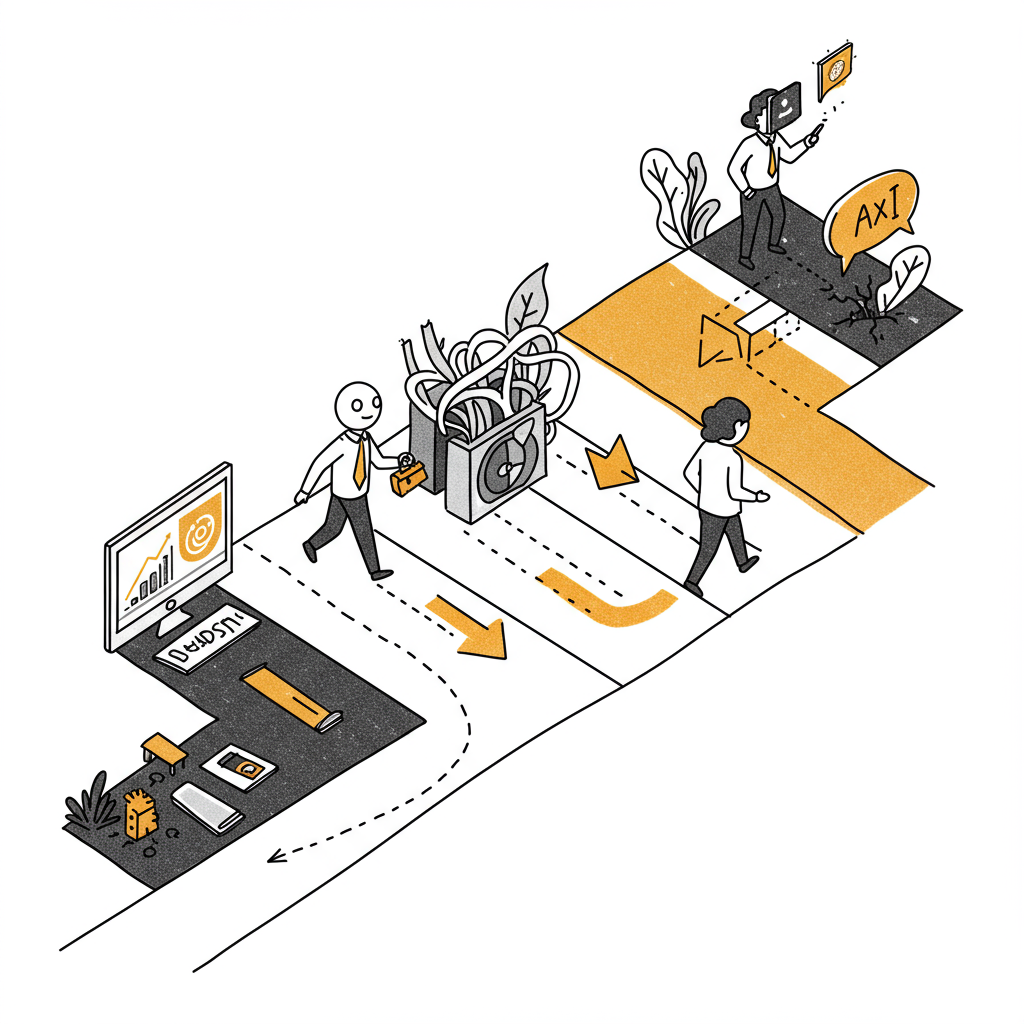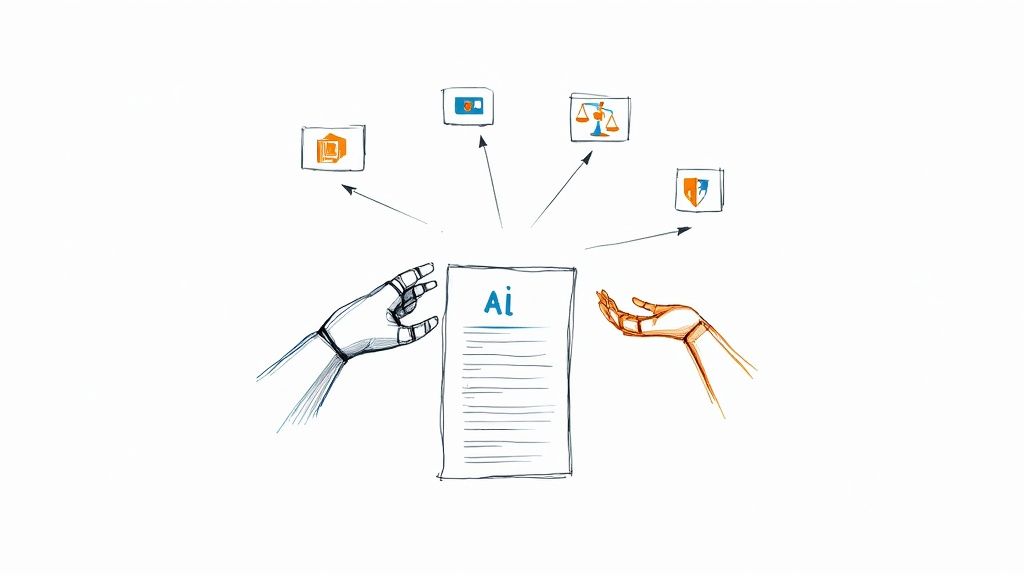Build Your Enterprise AI Strategy for Business Growth
Discover how to build a powerful enterprise AI strategy. This guide offers a practical framework, real-world examples, and expert advice to drive innovation.

So, what exactly is an enterprise AI strategy? Think of it less as a technical document and more as a detailed battle plan that connects every AI initiative—big or small—to your company's most important business goals. It’s the essential bridge between the raw potential of artificial intelligence and real, measurable results.
Without a strategy, you’re essentially just playing with new tech. With one, you're deliberately building a smarter, more competitive business.
Why an Enterprise AI Strategy Is No Longer a "Nice-to-Have"
Jumping into artificial intelligence without a clear strategy is like trying to build a house without a blueprint. You might get a few walls up, but you'll waste a lot of time and money, and the final structure will almost certainly be unstable. You're far more likely to end up with a collection of disconnected, expensive projects that don't actually move the needle for your business.
A well-crafted enterprise AI strategy provides that essential blueprint. It turns random acts of innovation into a coordinated effort to drive growth, efficiency, and a real competitive edge.
The data tells a sobering story. We see that over 30% of generative AI pilots never make it past the proof-of-concept stage. Why? Most often, it's because there was no strategic direction from the start. An AI strategy isn't just for your tech team; it’s a business plan that ensures every dollar invested in AI is working toward a specific, valuable outcome.
Aligning AI with Business Goals

The first job of any AI strategy is to make sure your tech efforts are aimed squarely at your core business objectives. This helps you avoid the classic trap of chasing "AI for AI's sake" and instead keeps the focus on solving genuine problems.
A solid strategy begins by asking the right questions:
Where will AI make the biggest impact? Should we focus on streamlining internal operations, creating a better customer experience, or getting new products to market faster?
Which parts of the business stand to gain the most? A good plan looks for opportunities across the entire organization, from marketing and sales to HR and finance.
How will we know if we're winning? You need clear success metrics, whether that’s reduced operational costs, a jump in revenue, or higher customer satisfaction scores.
This business-first mindset is the cornerstone of any effective AI strategy consulting engagement and is what separates successful implementations from failed experiments.
An effective enterprise AI strategy doesn't just install new technology—it changes the way your business works. It keeps AI focused on your mission, turning potential into profit and innovation into a lasting advantage.
Building a Foundation for Scalable Success
A formal strategy does more than just align projects; it builds the organizational muscle needed to scale AI successfully and responsibly. It forces you to think through the critical infrastructure that often gets ignored in the initial excitement. This means creating a solid AI strategy framework that sets clear rules for everything from data governance and tech choices to ethical guidelines and employee training.
To get this right, you need to bring everyone to the table. The best strategies are born from AI co creation, a process that involves leaders, IT experts, data scientists, and the people on the front lines who will actually use these tools. Getting everyone involved from the start ensures your AI solutions are not only technically sound but also genuinely useful.
This summary table outlines the core components that come together to form a robust enterprise AI strategy.
Core Pillars of an Effective Enterprise AI Strategy
Pillar | Description | Business Impact |
|---|---|---|
Business Alignment | Clearly defines how each AI initiative will support specific, high-level business objectives and solve real-world problems. | Ensures AI investments deliver measurable ROI and contribute directly to growth, efficiency, or innovation. |
Data Governance | Establishes policies for data quality, security, privacy, and accessibility, ensuring a reliable foundation for AI models. | Mitigates risk, builds trust, and improves the accuracy and reliability of AI-driven insights. |
Technology & Infrastructure | Outlines the required tools, platforms, and architecture (e.g., cloud, on-premise) needed to support AI development and deployment. | Creates a scalable and secure environment that prevents tech debt and supports long-term AI ambitions. |
Talent & Culture | Focuses on upskilling the workforce, fostering a data-driven culture, and defining new roles and responsibilities. | Empowers employees to adopt and champion AI, accelerating adoption and unlocking its full potential. |
Ethics & Responsibility | Sets clear guidelines for fairness, transparency, and accountability in AI systems to avoid bias and build user trust. | Protects brand reputation, ensures regulatory compliance, and promotes the responsible use of AI. |
By taking this coordinated approach, you avoid creating isolated pockets of expertise and ensure your AI investments benefit the entire organization, setting the stage for sustainable success.
Understanding the Current State of Enterprise AI
The conversation around artificial intelligence in business has completely changed. Not long ago, AI was the stuff of isolated experiments tucked away in R&D labs. Now, it's a top-line priority in the boardroom. We're seeing a massive shift as AI moves from a niche, experimental technology to a core tool woven directly into how companies operate.
This isn't just a passing trend; it's a matter of competitive survival. The question is no longer if a company should adopt AI, but how fast it can scale it across the entire organization to find new efficiencies and unlock real growth.

From Pilot Projects to Pervasive Integration
The first wave of AI in the business world was all about small, contained pilot projects. These were great for learning, but they rarely delivered a meaningful impact on the bottom line. Today, the game has changed. The real focus is on full-scale integration, embedding AI capabilities right into the daily workflows that actually drive the business.
And this shift is happening at a breathtaking pace. The explosion of accessible generative AI has been a huge catalyst, demonstrating its value in practical ways that go far beyond simple automation. Because of this, senior executives are now getting hands-on with these tools, which is directly shaping top-level decisions and fueling a more aggressive enterprise AI strategy.
The numbers tell the story. By 2025, it's expected that over 70% of global enterprises will use AI in at least one business function. That’s a huge leap from around 50% just a year ago. A lot of this growth is thanks to generative AI, with research from Stack AI showing that more than two-thirds of senior execs now use it for tasks in marketing, sales, product development, and IT. AI is no longer on the fringes; it's firmly embedded in operations.
The New Competitive Landscape
This rapid, widespread adoption is creating intense pressure. If your organization is slow to build a coherent AI strategy, you risk being left behind for good. The advantage now belongs to companies that can deploy AI effectively, not just in a single department, but across the entire value chain.
Think about where AI is quickly becoming standard practice:
Marketing and Sales: AI is crafting hyper-personalized customer campaigns, forecasting sales trends, and automating lead scoring to boost revenue.
IT and Operations: Teams are automating routine system maintenance, tightening network security, and using predictive analytics to prevent costly downtime. An AI Strategy consulting tool can be a great starting point for pinpointing where to begin.
Customer Service: AI-powered chatbots and virtual assistants now handle a massive volume of customer questions, freeing up human agents to tackle more complex, high-touch issues.
This integration makes one thing crystal clear: a successful enterprise AI strategy is no longer about having the fanciest algorithm. It's about building a company that can systematically spot problems, apply the right AI solution, and learn and improve over time.
The new benchmark for success isn't just adopting AI—it's achieving AI maturity. This means moving beyond isolated use cases to create a connected, intelligent ecosystem where AI enhances decision-making and operations at every level.
Getting this right requires more than just good technology; it demands a clear vision and a structured plan. As we explored in our AI adoption guide, you need a holistic approach to turn AI's potential into a real, sustainable advantage. Working with our expert team can bring the clarity and direction needed to build a strategy that won't just survive, but thrive.
Building Your AI Strategy Framework Step-by-Step
So, how do you go from talking about an "enterprise AI strategy" to actually having a concrete plan? It’s all about following a structured framework. This isn't about chasing the latest tech trend; it's about methodically weaving AI into the fabric of your business to solve real problems.
Think of it like building a house. You wouldn't just start throwing up walls. You need a solid foundation, a strong frame, and detailed blueprints. This step-by-step guide is your blueprint for creating a living strategy that guides decisions, allocates resources wisely, and gets everyone pulling in the same direction.
Step 1: Define Clear Business Objectives
This is the most critical step, and it's where most companies get it wrong. They start with the technology. Don't. Your first move is to anchor every single potential AI project to a specific business goal. Without a clear "why," your AI initiatives will inevitably drift and fail to deliver any real value.
Get your leadership team in a room and ask the hard questions:
What are our biggest headaches right now? Are we bleeding money on operational costs? Losing customers? Taking too long to get new products to market?
Where are our best chances for growth? Can we create entirely new revenue streams, push into new markets, or make our customers fiercely loyal?
What does success look like in 12–24 months? Define the specific, measurable KPIs that AI is expected to improve.
This ensures your enterprise AI strategy is driven by purpose from day one. For example, a goal to "cut customer service costs by 15%" is a powerful starting point. A vague desire to "use a chatbot" is not.
A strategy without clear business objectives is just an expensive experiment. A strategy driven by business objectives is an investment in your company's future.
Step 2: Assess Current Capabilities and Data Readiness
Once you know why you're doing this, you need to take a brutally honest look in the mirror. You have to understand what you're working with—your strengths, and more importantly, your weaknesses. This reality check should cover three main areas: your data, your tech, and your people.
Data Readiness: AI is fueled by data. Is your data clean, reliable, and accessible? Or is it locked away in a dozen different systems that don't talk to each other?
Technology Infrastructure: Look at your current tech stack. Can it handle the heavy lifting of training, deploying, and scaling AI models? This means evaluating your computing power, storage, and how well new tools can integrate.
Talent and Skills: Do you have the right people on board? We're talking about data scientists, machine learning engineers, and project managers who get AI. A skills gap analysis now will tell you who you need to hire or train.
This internal audit gives you a realistic baseline. It stops you from getting excited about projects your organization simply isn't ready to handle.
This simple flow chart really captures the essence of turning strategy into reality.

As the visual shows, everything starts with your vision and data readiness before you even think about execution. It all comes back to that foundational prep work.
Step 3: Prioritize High-Impact AI Use Cases
You can't do everything at once, so don't even try. The next move is to find and prioritize a handful of AI projects that offer the best bang for your buck—high business value combined with a realistic chance of success. This is where you connect your business goals from Step 1 to specific, tangible applications.
Start by brainstorming ideas across every department. Then, score each potential project against a few key criteria:
Business Impact: How much will this actually move the needle on our KPIs?
Feasibility: Do we realistically have the data, tech, and people to get this done?
Complexity: How hard is this going to be? How much time will it take?
Zero in on the "quick wins"—projects that can show real, measurable value in three to six months. Nailing these first pilots builds incredible momentum. It gets stakeholders excited, secures more funding, and teaches you valuable lessons for the bigger, more ambitious projects you'll tackle later. You can find more inspiration by looking at real-world use cases that show what's possible.
Step 4: Develop Your Roadmap and Governance
With your priorities locked in, it’s time to draw the map. This is the part of your enterprise AI strategy that lays out the who, what, and when. Your roadmap should detail everything from technology purchases and hiring plans to clear project timelines.
At the same time, you have to build a strong governance framework. This is non-negotiable for doing AI responsibly. Your governance plan needs to clearly define:
Ethical Guidelines: Your principles for fairness, transparency, and accountability. This is how you prevent bias and build trust.
Data Security and Privacy: Hard rules for how data is handled, stored, and protected.
Roles and Responsibilities: A clear chain of command for oversight, often including an AI review board or ethics committee.
A solid governance plan protects you from risk and makes sure your AI efforts reflect your company's values and comply with regulations.
Overcoming Common AI Adoption and Scaling Hurdles
Crafting a brilliant enterprise AI strategy is one thing. Actually bringing it to life? That’s a whole different beast. So many organizations stumble right here, discovering a massive gap between their ambitions on paper and the messy reality of execution. This is where the real work begins—facing down the stubborn roadblocks that can derail even the most well-laid plans.
Getting AI to scale successfully means you have to get your hands dirty and tackle the practical hurdles that pop up. We’re talking about deep-rooted issues, like data being locked away in departmental silos, a chronic shortage of people with the right skills, and a culture that’s resistant to change. You also see a fundamental disconnect between the tech folks and the business leaders. A great plan isn't enough; you have to actively tear down these walls.

Bridging the Gap Between IT and Business
One of the most common friction points I see is the disconnect between the IT department and the rest of the business. The IT teams are often laser-focused on technical specs and infrastructure, while business leaders are thinking about customer needs and ROI. When these two groups aren't speaking the same language or working toward the same goals, AI projects get stuck in silos, burn through resources, and ultimately miss the mark.
The data on this is pretty clear. One recent study found that a staggering 68% of executives admitted to major tension between their IT departments and other business units. To make matters worse, 72% said AI solutions were being built in departmental bubbles, with zero cross-functional teamwork. That kind of siloed approach is a recipe for disaster.
The AI strategies that truly succeed aren't cooked up in one department. They are the result of genuine collaboration, where tech experts and business leaders work side-by-side from day one to define problems and build solutions.
To close this gap, you need strong leadership. It’s simply not optional. Leaders have to champion a culture where open communication and shared ownership are the norm. This means putting together dedicated, cross-functional teams for specific AI initiatives, ensuring both tech and business perspectives are heard and valued throughout the entire project.
The Non-Negotiable Role of a Mature Data Strategy
Behind almost every other challenge lies the big one: data. Let's be blunt—you can't scale AI without a mature, well-governed data strategy. Too many companies underestimate the foundational work needed, thinking they can just sprinkle some AI on top of their existing data mess. This is a critical mistake.
A solid data foundation is the absolute prerequisite for any meaningful AI success. This involves:
Breaking Down Data Silos: You need to consolidate data from all your scattered systems to create a single, reliable source of truth.
Ensuring Data Quality: This means putting processes in place to clean, validate, and maintain high-quality data. Garbage in, garbage out.
Establishing Clear Governance: You must define clear rules for who can access data, how it can be used, and how it’s kept secure and private.
Companies with mature data strategies consistently run circles around their peers in AI adoption. They move faster and with more confidence because they have a reliable fuel source for their AI models. Those who are still flying by the seat of their pants with fragmented data find themselves bogged down by friction and slow progress.
From Strategy to Execution
Navigating these hurdles isn't about luck; it's about having a deliberate and structured plan. The first step is identifying the potential roadblocks in your enterprise AI strategy, but the real key to success is proactively knocking them down. For a transformation this complex, getting the right guidance can make all the difference. Our hands-on implementation support is designed to help businesses turn strategic plans into real-world results, ensuring these common hurdles don’t stop you in your tracks.
By anticipating these challenges and fostering a collaborative, data-first culture, you can finally turn your strategic vision into a scalable and impactful reality.
The Human Element in Your AI Transformation
An enterprise AI strategy is ultimately about people, not just platforms. It’s easy to get caught up in the technology, but the most advanced algorithm in the world won’t do a thing if your team doesn't trust it, your leaders don't champion it, and your company culture resists the change.
While AI investment is booming, the real roadblocks are human ones: leadership hesitation and a workforce that isn’t quite ready. That’s why a smart strategy has to put people first. The goal is to turn that potential resistance into genuine enthusiasm and get everyone aligned on what an AI-powered future actually looks like for your business.
Leadership as the Driving Force
Real AI adoption has to start at the top. It’s not enough for leaders to just sign the checks; they need to be the most visible and vocal champions of the company's AI vision. Their job is to pull back the curtain on AI, explain why it's so important for the company's long-term health, and create an environment where it's okay to experiment—and even to fail, as long as you learn something.
This means getting their hands dirty. Leaders should be in the room helping to define the goals for AI projects. More importantly, they need to constantly communicate how these tools will help employees do their jobs better, not replace them. When people see the C-suite using new AI-driven workflows and celebrating the wins, it sends a clear signal: this isn't a fad, it's our future.
A successful AI strategy is less about mandating technology and more about inspiring a movement. It's about showing people how AI can make their work more meaningful, strategic, and impactful.
Preparing Your Workforce for an AI-Powered Future
Right after leadership, getting your employees ready for this shift is the most critical investment you can make. People are naturally worried about their jobs, and you can’t just ignore that fear. The best approach is to tackle it head-on with proactive upskilling and reskilling programs, which is a crucial step as we explored in our AI adoption guide.
Think about putting these actions into motion:
Invest in Continuous Learning: Make training easy to access. Focus on practical AI skills, basic data literacy, and what it really means to work alongside an AI system.
Redefine Roles and Responsibilities: Shift the conversation to how AI can handle the repetitive, boring stuff. This frees up your team to focus on what humans do best: strategic thinking, creativity, and solving complex problems.
Foster a Culture of AI co-creation: Get employees from all over the company involved in designing and rolling out the new tools. When people help build the solution, they’re far more likely to actually use it.
The data makes it clear this can't wait. Between 2024 and 2025, enterprise AI adoption shot up to a global high of 72% to 78%. And yet, only a tiny 1% of companies feel they've truly mastered AI, mostly because of these very human hurdles. With generative AI expected to change over 30% of regular work tasks, getting your workforce ready isn't optional anymore.
This is a massive change, and it puts building trust and empowering your people at the very center of any workable enterprise AI strategy. You're aiming for a partnership where technology automates the routine so your team can drive the innovation. To see how you can align your team and create a solid plan, our AI strategy consulting offers the expert guidance to help you manage this human side of the transformation.
Your Next Steps on the AI Strategy Journey
You've now got the map for your enterprise AI strategy, but a map is only useful once you start moving. The most successful AI initiatives I've seen all boil down to the same core principles: they are driven by clear business goals, designed for the people who will actually use them, and built on a rock-solid data foundation. If any of those pillars are shaky, even the most impressive tech will fall flat.
So, how do you go from planning to actually doing? Here's a simple checklist to get your journey started.
Form Your AI Vanguard: Don't silo this in the IT department. Pull together a task force with leaders from your business units, IT, and data science teams. This mix of perspectives is your best defense against building something technically brilliant but practically useless.
Take an Honest Look in the Mirror: How ready are you, really? Scrutinize your data quality, your infrastructure, and your team's current skills. A formal AI requirements analysis is a great tool here to get a clear, unbiased picture of what you have versus what you'll need.
Find Your Quick Wins: You don't need to reinvent your entire company overnight. Find one or two pilot projects that are high-impact but genuinely achievable. This is all about building momentum and proving the concept. If you need some ideas, check out our library of real-world use cases for inspiration.
Remember, the leap from a beautifully written strategy document to a functioning AI system is where most plans fail. The secret is to start small, show tangible results quickly, and build on that success.
This path can feel daunting, and you don’t have to walk it alone. Bringing in experts who have been down this road before can help you move faster and avoid the common traps that snag so many companies. A good AI strategy consulting partner brings the structured thinking and hands-on experience needed to translate your vision into a working reality. You can also use our specialized AI Strategy consulting tool to jumpstart your initial planning process.
Feel free to connect with our expert team. We’d be happy to talk through your specific challenges and help you build a plan that delivers.
Frequently Asked Questions
When leaders start exploring an enterprise AI strategy, a handful of practical questions always come up. Getting these answered early on can clear up common myths and give you the confidence to move forward. Let's tackle a few of the big ones.
For a deeper dive, feel free to check out our complete enterprise AI FAQ page.
What Is the First Step in Creating an Enterprise AI Strategy?
Forget the technology for a moment. The most important first step is all about your business objectives.
Start by getting crystal clear on the specific problems you need to solve or the opportunities you want to chase with AI. Every single initiative should tie back to a core company goal, whether that's boosting revenue, making operations more efficient, or delighting your customers. You have to establish a solid "why" before you even whisper the word "algorithm." This ensures your strategy has a purpose from the very beginning and a clear line to delivering a real return.
How Do I Measure the ROI of My AI Strategy?
Measuring the return on an AI investment is a blend of art and science—you need to track both hard numbers and softer, but equally important, improvements.
To get the full picture, you should monitor:
Quantitative Metrics: These are the straightforward figures. Think cost savings from new automation, revenue lifts from AI-powered sales insights, or a drop in production cycle times.
Qualitative Metrics: These track the less tangible benefits. Keep an eye on things like customer satisfaction scores (NPS), employee productivity, and how much faster your teams can make critical decisions.
The key is to establish baseline metrics before you implement anything. That's the only way to accurately measure the "after." Tie every AI project to a specific business KPI. For example, connect a new AI chatbot directly to a reduction in customer service calls and faster ticket resolution times.
Who Should Be on the AI Strategy Team?
This is a big one. Your AI strategy team can't just be the IT or data science department. That's a classic mistake that results in technically brilliant solutions that nobody in the business can actually use.
A successful AI team absolutely must be cross-functional. It should feel like a microcosm of the company itself.
Make sure you have people from:
Key Business Units: You need the domain experts from marketing, finance, operations, and other departments to ground the strategy in reality.
IT and Data Experts: These are your technical minds who can assess what's possible and manage the implementation.
A Dedicated Project Manager: Someone has to keep the train on the tracks, managing timelines and resources.
A Senior Executive Sponsor: This is your champion—the person who can clear organizational hurdles and advocate for the initiative in the C-suite.
This mix ensures your strategy is not only technically sound but also directly addresses real business needs and has the support to see it through.
Ready to build a strategy that delivers real, measurable results? The team at Ekipa AI can help you turn your AI vision into an actionable plan in just 24 hours.



